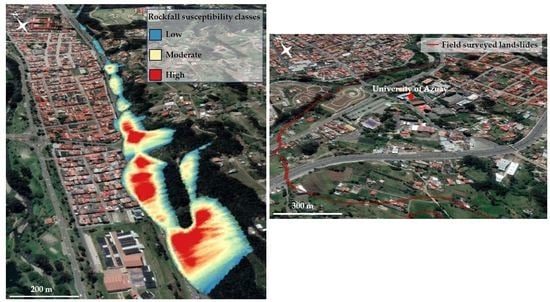Landslide Awareness System (LAwS) to Increase the Resilience and Safety of Transport Infrastructure: The Case Study of Pan-American Highway (Cuenca–Ecuador)
Abstract
:1. Introduction
2. Pan-American Highway Cuenca–Azogues (Troncal de la Sierra E35)
3. Geological Setting
4. Materials and Methods
4.1. Multi-Approach Landslide Inventory
4.2. Identification of Potential Rockfall Sectors
5. Results
5.1. Multi-Approach Landslide Inventory
5.2. Identification of Potential Rockfall Sectors with QPROTO
6. Discussion
7. Conclusions
Author Contributions
Funding
Data Availability Statement
Acknowledgments
Conflicts of Interest
References
- Fassin, D.; Vasquez, P. Humanitarian Exception as the Rule: The Political Theology of the 1999 Tragedia in Venezuela. Am. Ethnol. 2005, 32, 389–405. [Google Scholar] [CrossRef]
- Vranken, L.; Van Turnhout, P.; Van Den Eeckhaut, M.; Vandekerckhove, L.; Poesen, J. Economic Valuation of Landslide Damage in Hilly Regions: A Case Study from Flanders, Belgium. Sci. Total Environ. 2013, 447, 323–336. [Google Scholar] [CrossRef] [Green Version]
- Infante, D.; Di Martire, D.; Calcaterra, D.; Miele, P.; Scotto di Santolo, A.; Ramondini, M. Integrated Procedure for Monitoring and Assessment of Linear Infrastructures Safety (I-Pro MONALISA) Affected by Slope Instability. Appl. Sci. 2019, 9, 5535. [Google Scholar] [CrossRef] [Green Version]
- Leroi, E. Science versus Economy and Sociology: Balanced Modeling for a Balanced Protection... How to Fit the Needs of the Society? Ital. J. Geosci. 2013, 132, 330–340. [Google Scholar] [CrossRef]
- Anderson, M.G.; Holcombe, E. Community-Based Landslide Risk Reduction: Managing Disasters in Small Steps; World Bank Publications: Washington, DC, USA, 2013; ISBN 978-0-8213-9491-5. [Google Scholar]
- Martino, S.; Bozzano, F.; Caporossi, P.; D’Angiò, D.; Della Seta, M.; Esposito, C.; Fantini, A.; Fiorucci, M.; Giannini, L.M.; Iannucci, R. Impact of Landslides on Transportation Routes during the 2016–2017 Central Italy Seismic Sequence. Landslides 2019, 16, 1221–1241. [Google Scholar] [CrossRef]
- Dragos, K.; Smarsly, K. Decentralized infrastructure health monitoring using embedded computing in wireless sensor networks. In Dynamic Response of Infrastructure to Environmentally Induced Loads; Springer: Berlin, Germany, 2017; pp. 183–201. [Google Scholar]
- Fornaro, G.; Reale, D.; Verde, S. Potential of SAR for Monitoring Transportation Infrastructures: An Analysis with the Multi-Dimensional Imaging Technique. J. Geophys. Eng. 2012, 9, S1–S9. [Google Scholar] [CrossRef]
- Corominas, J.; van Westen, C.; Frattini, P.; Cascini, L.; Malet, J.-P.; Fotopoulou, S.; Catani, F.; Van Den Eeckhaut, M.; Mavrouli, O.; Agliardi, F.; et al. Recommendations for the Quantitative Analysis of Landslide Risk. Bull. Eng. Geol. Env. 2014, 73, 209–263. [Google Scholar] [CrossRef]
- Meyer, V.; Becker, N.; Markantonis, V.; Schwarze, R.; van den Bergh, J.C.J.M.; Bouwer, L.M.; Bubeck, P.; Ciavola, P.; Genovese, E.; Green, C.; et al. Review Article: Assessing the Costs of Natural Hazards—State of the Art and Knowledge Gaps. Nat. Hazards Earth Syst. Sci. 2013, 13, 1351–1373. [Google Scholar] [CrossRef]
- Alexander, D. Vulnerability to Landslides. In Landslide Hazard Risk; John Wiley & Sons, Inc.: Hoboken, NJ, USA, 2005; pp. 175–198. [Google Scholar]
- Papathoma-Köhle, M.; Kappes, M.; Keiler, M.; Glade, T. Physical Vulnerability Assessment for Alpine Hazards: State of the Art and Future Needs. Nat. Hazards 2011, 58, 645–680. [Google Scholar] [CrossRef]
- Franceschetti, G.; Migliaccio, M.; Riccio, D.; Schirinzi, G. SARAS: A Synthetic Aperture Radar(SAR) Raw Signal Simulator. IEEE Trans. Geosci. Remote Sens. 1992, 30, 110–123. [Google Scholar] [CrossRef]
- Bakon, M.; Perissin, D.; Lazecky, M.; Papco, J. Infrastructure Non-Linear Deformation Monitoring via Satellite Radar Interferometry. Procedia Technol. 2014, 16, 294–300. [Google Scholar] [CrossRef] [Green Version]
- Poreh, D.; Iodice, A.; Riccio, D.; Ruello, G. Railways’ Stability Observed in Campania (Italy) by InSAR Data. Eur. J. Remote Sens. 2016, 49, 417–431. [Google Scholar] [CrossRef] [Green Version]
- Orellana, F.; Delgado Blasco, J.M.; Foumelis, M.; D’Aranno, P.J.V.; Marsella, M.A.; Di Mascio, P. DInSAR for Road Infrastructure Monitoring: Case Study Highway Network of Rome Metropolitan (Italy). Remote Sens. 2020, 12, 3697. [Google Scholar] [CrossRef]
- North, M.; Farewell, T.; Hallett, S.; Bertelle, A. Monitoring the Response of Roads and Railways to Seasonal Soil Movement with Persistent Scatterers Interferometry over Six UK Sites. Remote Sens. 2017, 9, 922. [Google Scholar] [CrossRef] [Green Version]
- Zhu, M.; Wan, X.; Fei, B.; Qiao, Z.; Ge, C.; Minati, F.; Vecchioli, F.; Li, J.; Costantini, M. Detection of Building and Infrastructure Instabilities by Automatic Spatiotemporal Analysis of Satellite SAR Interferometry Measurements. Remote Sens. 2018, 10, 1816. [Google Scholar] [CrossRef] [Green Version]
- Peduto, D.; Giangreco, C.; Venmans, A.A. Differential Settlements Affecting Transition Zones between Bridges and Road Embankments on Soft Soils: Numerical Analysis of Maintenance Scenarios by Multi-Source Monitoring Data Assimilation. Transp. Geotech. 2020, 24, 100369. [Google Scholar] [CrossRef]
- Bekaert, D.P.S.; Handwerger, A.L.; Agram, P.; Kirschbaum, D.B. InSAR-Based Detection Method for Mapping and Monitoring Slow-Moving Landslides in Remote Regions with Steep and Mountainous Terrain: An Application to Nepal. Remote Sens. Environ. 2020, 249, 111983. [Google Scholar] [CrossRef]
- Montalti, R.; Solari, L.; Bianchini, S.; Soldato, M.D.; Raspini, F.; Casagli, N. A Sentinel-1-Based Clustering Analysis for Geo-Hazards Mitigation at Regional Scale: A Case Study in Central Italy. Geomat. Nat. Hazards Risk 2019, 10, 2257–2275. [Google Scholar] [CrossRef] [Green Version]
- Zhao, C.; Kang, Y.; Zhang, Q.; Lu, Z.; Li, B. Landslide Identification and Monitoring along the Jinsha River Catchment (Wudongde Reservoir Area), China, Using the InSAR Method. Remote Sens. 2018, 10, 993. [Google Scholar] [CrossRef] [Green Version]
- Mignelli, C.; Peila, D.; Russo, S.L.; Ratto, S.M.; Broccolato, M. Analysis of Rockfall Risk on Mountainside Roads: Evaluation of the Effect of Protection Devices. Nat. Hazards 2014, 73, 23–35. [Google Scholar] [CrossRef]
- Cloutier, C.; Locat, J.; Mayers, M.; Noël, F.; Turmel, D.; Jacob, C.; Dorval, P.; Bossé, F.; Gionet, P.; Jaboyedoff, M. An Integrated Management Tool for Rockfall Evaluation along Transportation Corridors: Description and Objectives of the ParaChute Research Project. In Proceedings of the GEOQuébec 2015, Québec City, QC, Canada, 21–23 September 2015. [Google Scholar]
- Donnini, M.; Napolitano, E.; Salvati, P.; Ardizzone, F.; Bucci, F.; Fiorucci, F.; Santangelo, M.; Cardinali, M.; Guzzetti, F. Impact of Event Landslides on Road Networks: A Statistical Analysis of Two Italian Case Studies. Landslides 2017, 14, 1521–1535. [Google Scholar] [CrossRef]
- Confuorto, P.; Di Martire, D.; Centolanza, G.; Iglesias, R.; Mallorqui, J.J.; Novellino, A.; Plank, S.; Ramondini, M.; Thuro, K.; Calcaterra, D. Post-Failure Evolution Analysis of a Rainfall-Triggered Landslide by Multi-Temporal Interferometry SAR Approaches Integrated with Geotechnical Analysis. Remote Sens. Environ. 2017, 188, 51–72. [Google Scholar] [CrossRef]
- Frodella, W.; Ciampalini, A.; Gigli, G.; Lombardi, L.; Raspini, F.; Nocentini, M.; Scardigli, C.; Casagli, N. Synergic Use of Satellite and Ground Based Remote Sensing Methods for Monitoring the San Leo Rock Cliff (Northern Italy). Geomorphology 2016, 264, 80–94. [Google Scholar] [CrossRef]
- Carlà, T.; Intrieri, E.; Raspini, F.; Bardi, F.; Farina, P.; Ferretti, A.; Colombo, D.; Novali, F.; Casagli, N. Perspectives on the Prediction of Catastrophic Slope Failures from Satellite InSAR. Sci. Rep. 2019, 9, 14137. [Google Scholar] [CrossRef] [PubMed] [Green Version]
- Di Napoli, M.; Di Martire, D.; Bausilio, G.; Calcaterra, D.; Confuorto, P.; Firpo, M.; Pepe, G.; Cevasco, A. Rainfall-Induced Shallow Landslide Detachment, Transit and Runout Susceptibility Mapping by Integrating Machine Learning Techniques and GIS-Based Approaches. Water 2021, 13, 488. [Google Scholar] [CrossRef]
- Volkwein, A.; Schellenberg, K.; Labiouse, V.; Agliardi, F.; Berger, F.; Bourrier, F.; Dorren, L.K.A.; Gerber, W.; Jaboyedoff, M. Rockfall Characterisation and Structural Protection—A Review. Nat. Hazards Earth Syst. Sci. 2011, 11, 2617–2651. [Google Scholar] [CrossRef] [Green Version]
- Chen, G.; Zheng, L.; Zhang, Y.; Wu, J. Numerical Simulation in Rockfall Analysis: A Close Comparison of 2-D and 3-D DDA. Rock Mech. Rock Eng. 2013, 46, 527–541. [Google Scholar] [CrossRef]
- Jaboyedoff, M.; Labiouse, V. Preliminary Estimation of Rockfall Runout Zones. Nat. Hazards Earth Syst. Sci. 2011, 11, 819–828. [Google Scholar] [CrossRef] [Green Version]
- Castelli, M.; Torsello, G.; Vallero, G. Preliminary Modeling of Rockfall Runout: Definition of the Input Parameters for the QGIS Plugin QPROTO. Geosciences 2021, 11, 88. [Google Scholar] [CrossRef]
- Scavia, C.; Barbero, M.; Castelli, M.; Marchelli, M.; Peila, D.; Torsello, G.; Vallero, G. Evaluating Rockfall Risk: Some Critical Aspects. Geosciences 2020, 10, 98. [Google Scholar] [CrossRef] [Green Version]
- Plaza, G.; Zevallos, O.; Cadier, É. La Josefina Landslide Dam and Its Catastrophic Breaching in the Andean Region of Ecuador. In Natural and artificial rockslide dams; Springer: Berlin, Germany, 2011; pp. 389–406. [Google Scholar]
- Di Martire, D.; Confuorto, P.; Frezza, A.; Ramondini, M.; Lòpez, A.V.; Del Rosso, M.P.; Sebastianelli, A.; Ullo, S.L. X-and C-Band SAR Data to Monitoring Ground Deformations and Slow-Moving Landslides for the 2016 Manta and Portoviejo Earthquake (Manabi, Ecuador). In Proceedings of the 2018 IEEE International Conference on Environmental Engineering (EE), Milan, Italy, 12–14 March 2018; pp. 1–6. [Google Scholar]
- Sellers, C.; Rodas, R.; Carrasco, N.P.; De Stefano, R.; Di Martire, D.; Ramondini, M. Ground Deformation Monitoring of a Strategic Building Affected by Slow-Moving Landslide in Cuenca (Ecuador). In European Workshop on Structural Health Monitoring; Rizzo, P., Milazzo, A., Eds.; Springer International Publishing: Cham, Switzerland, 2021; pp. 149–158. [Google Scholar]
- Muenchow, J.; Brenning, A.; Richter, M. Geomorphic Process Rates of Landslides along a Humidity Gradient in the Tropical Andes. Geomorphology 2012, 139–140, 271–284. [Google Scholar] [CrossRef]
- Schuster, R.L.; Highl, L.M. Socioeconomic and Environmental Impacts of Landslides in the Western Hemisphere; USGS Open-File Report, 01–276; U.S. Geological Survey: Denver, CO, USA, 2001.
- Basabe, P.; Almeida, E.; Ramon, P.; Zeas, R.; Alvarez, L. Avance En La Prevención de Desastres Naturales En La Cuenca Del Río Paute, Ecuador. Bull. De L’institut Fr. D’études Andin. 1996, 25, 443–458. [Google Scholar]
- Bignami, D.F.; Dragoni, A.; Menduni, G. Assessing and Improving Flood and Landslide Community Social Awareness and Engagement via a Web Platform: The Case of Italy. Int. J. Disaster Risk Sci. 2018, 9, 530–540. [Google Scholar] [CrossRef] [Green Version]
- Estudios de Ingeniería Definitivos de la Carretera Cuenca-Azogues-Biblián; Ministerio de Transportes y Obras Públicas: Quito, Ecuador, 2019; p. 71.
- LITHERLAND, M. The Metamorphic Belts of Ecuador. Br. Geol. Surv. Overseas Mem. 1994, 11, 1–147. [Google Scholar]
- Dunkley, P.N.; Gaibor, A. Mapa Geológico de La Cordillera Occidental Del Ecuador Entre 2-3 S., Escala 1/200.000. Codigem-Minist. De Energía Y Minas-Br. Geol. Surv. Publs. Quito 1998. [Google Scholar]
- Pratt, W.; Figueroa, J.; Flores, B. Geology of the Cordillera Occidental of Ecuador between 3°00’ and 4°00’S; World Bank Mining Development and Environmental Control Project: Quito, Ecuador, 1997; p. 58. [Google Scholar]
- Feininger, T.; Bristow, C.R. Cretaceous and Paleogene Geologic History of Coastal Ecuador. Geol. Rundsch. 1980, 69, 849–874. [Google Scholar] [CrossRef]
- Noblet, C.; Lavenu, A.; Marocco, R. Concept of Continuum as Opposed to Periodic Tectonism in the Andes. Tectonophysics 1996, 255, 65–78. [Google Scholar] [CrossRef]
- Hungerbühler, D.; Steinmann, M.; Winkler, W.; Seward, D.; Egüez, A.; Peterson, D.E.; Helg, U.; Hammer, C. Neogene Stratigraphy and Andean Geodynamics of Southern Ecuador. Earth-Sci. Rev. 2002, 57, 75–124. [Google Scholar] [CrossRef]
- Faucher, B.; Vernet, R.; Bizon, G.; Bizon, J.; Grekoff, N.; Lys, M.; Sigal, J. Sedimentary Formations in Ecuador. A Stratigraphic and Micropaleontological Survey. Bureau d’Études Industrielles et Coopération de l’Institut Français du Pétrole (BEICIP). 1971. [Google Scholar]
- Bristow, C.R. Sociedad Ecuatoriana de Geología y Geofísica. Guide to the Geology of the Cuenca Basin, Southern Ecuador; Ecuadorian Geological and Geophysical Society: Quito, Ecuador, 1973. [Google Scholar]
- Fiorillo, F.; Guerriero, L.; Capobianco, L.; Pagnozzi, M.; Revellino, P.; Russo, F.; Guadagno, F.M. Inventory of Vietri-Maiori Landslides Induced by the Storm of October 1954 (Southern Italy). J. Maps 2019, 15, 530–537. [Google Scholar] [CrossRef]
- Galli, M.; Ardizzone, F.; Cardinali, M.; Guzzetti, F.; Reichenbach, P. Comparing Landslide Inventory Maps. Geomorphology 2008, 94, 268–289. [Google Scholar] [CrossRef]
- Guerriero, L.; Confuorto, P.; Calcaterra, D.; Guadagno, F.M.; Revellino, P.; Di Martire, D. PS-Driven Inventory of Town-Damaging Landslides in the Benevento, Avellino and Salerno Provinces, Southern Italy. J. Maps 2019, 15, 619–625. [Google Scholar] [CrossRef] [Green Version]
- Scaioni, M.; Longoni, L.; Melillo, V.; Papini, M. Remote Sensing for Landslide Investigations: An Overview of Recent Achievements and Perspectives. Remote Sens. 2014, 6, 9600–9652. [Google Scholar] [CrossRef] [Green Version]
- Santangelo, M.; Marchesini, I.; Bucci, F.; Cardinali, M.; Fiorucci, F.; Guzzetti, F. An Approach to Reduce Mapping Errors in the Production of Landslide Inventory Maps. Nat. Hazards Earth Syst. Sci. 2015, 15, 2111–2126. [Google Scholar] [CrossRef] [Green Version]
- Ferretti, A.; Prati, C.; Rocca, F. Permanent Scatterers in SAR Interferometry. IEEE Trans. Geosci. Remote Sens. 2001, 39, 8–20. [Google Scholar] [CrossRef]
- Mora, O.; Mallorqui, J.J.; Broquetas, A. Linear and Nonlinear Terrain Deformation Maps from a Reduced Set of Interferometric SAR Images. IEEE Trans. Geosci. Remote Sens. 2003, 41, 2243–2253. [Google Scholar] [CrossRef]
- Iglesias, R.; Mallorqui, J.J.; Monells, D.; López-Martínez, C.; Fabregas, X.; Aguasca, A.; Gili, J.A.; Corominas, J. PSI Deformation Map Retrieval by Means of Temporal Sublook Coherence on Reduced Sets of SAR Images. Remote Sens. 2015, 7, 530–563. [Google Scholar] [CrossRef] [Green Version]
- Lu, P.; Casagli, N.; Catani, F.; Tofani, V. Persistent Scatterers Interferometry Hotspot and Cluster Analysis (PSI-HCA) for Detection of Extremely Slow-Moving Landslides. Int. J. Remote Sens. 2012, 33, 466–489. [Google Scholar] [CrossRef]
- Di Martire, D.; Tessitore, S.; Brancato, D.; Ciminelli, M.G.; Costabile, S.; Costantini, M.; Graziano, G.V.; Minati, F.; Ramondini, M.; Calcaterra, D. Landslide Detection Integrated System (LaDIS) Based on in-Situ and Satellite SAR Interferometry Measurements. Catena 2016, 137, 406–421. [Google Scholar] [CrossRef]
- Ammirati, L.; Mondillo, N.; Rodas, R.A.; Sellers, C.; Di Martire, D. Monitoring Land Surface Deformation Associated with Gold Artisanal Mining in the Zaruma City (Ecuador). Remote Sens. 2020, 12, 2135. [Google Scholar] [CrossRef]
- Cruden, D.M.; Varnes, D.J. Landslides: Investigation and Mitigation. Chapter 3—Landslide Types and Processes; Transportation Research Board Special Report 247; Transportation Research Board: Washington, DC, USA, 1996; pp. 36–75. [Google Scholar]
- Hungr, O.; Leroueil, S.; Picarelli, L. The Varnes Classification of Landslide Types, an Update. Landslides 2014, 11, 167–194. [Google Scholar] [CrossRef]
- Colesanti, C.; Ferretti, A.; Novali, F.; Prati, C.; Rocca, F. SAR Monitoring of Progressive and Seasonal Ground Deformation Using the Permanent Scatterers Technique. IEEE Trans. Geosci. Remote Sens. 2003, 41, 1685–1701. [Google Scholar] [CrossRef] [Green Version]
- Onofri, R.; Candian, C. Indagini Sui Limiti Di Massima Invasione Dei Blocchi Rocciosi Franati Durante Il Sisma Del Friuli Del 1976: Considerazioni Sulle Opere Di Difesa; Università Degli Studi Trieste: Milan, Italy, 1979. [Google Scholar]
- Saroglou, C. GIS-Based Rockfall Susceptibility Zoning in Greece. Geosciences 2019, 9, 163. [Google Scholar] [CrossRef] [Green Version]
- Blodgett, T.A.; Blizard, C.; Isacks, B.L. Andean landslide hazards. In Geomorphological Hazards in High Mountain Areas; Springer: Berlin, Germany, 1998; pp. 211–227. [Google Scholar]
- Notti, D.; Herrera, G.; Bianchini, S.; Meisina, C.; García-Davalillo, J.C.; Zucca, F. A Methodology for Improving Landslide PSI Data Analysis. Int. J. Remote Sens. 2014, 35, 2186–2214. [Google Scholar] [CrossRef]


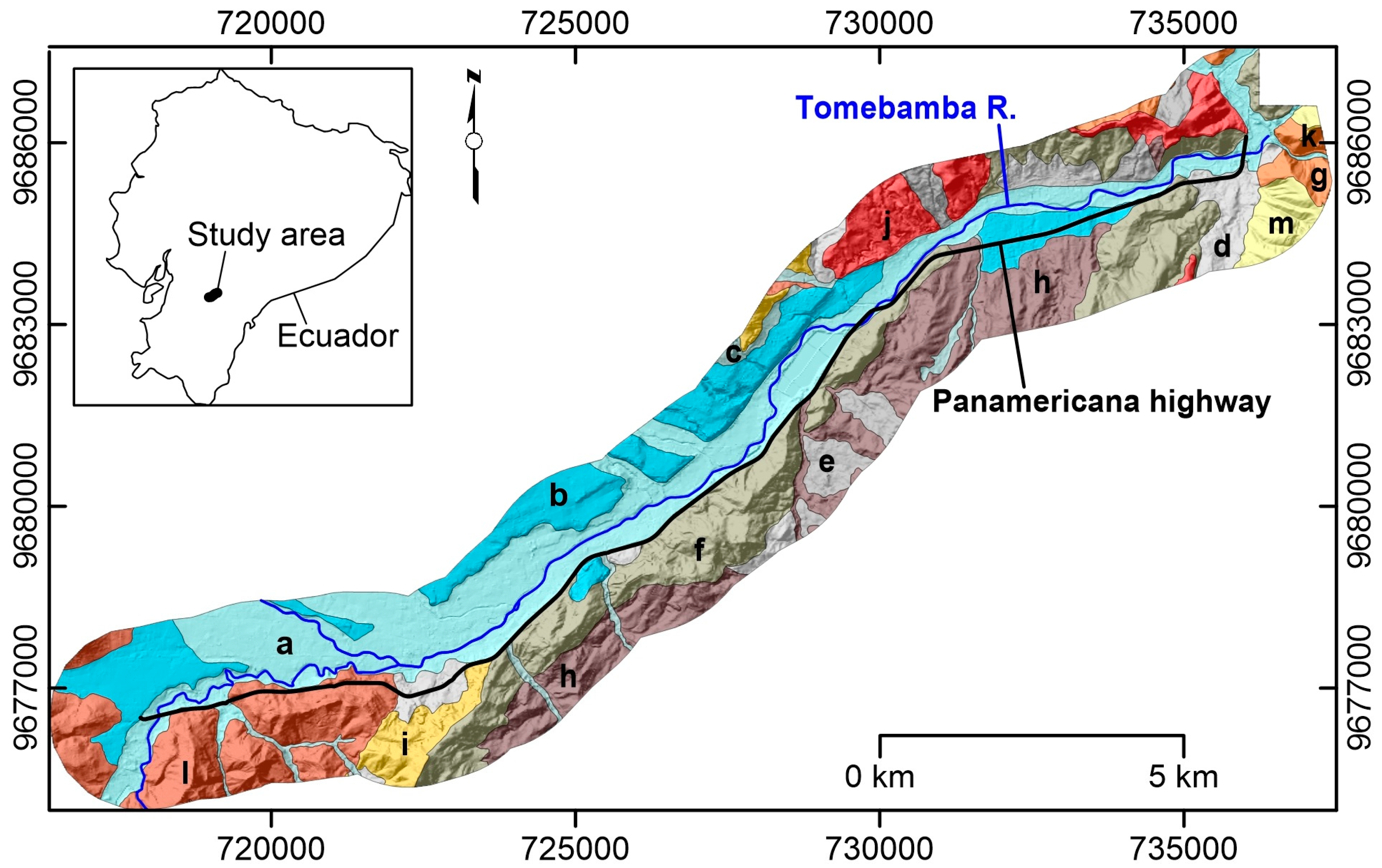

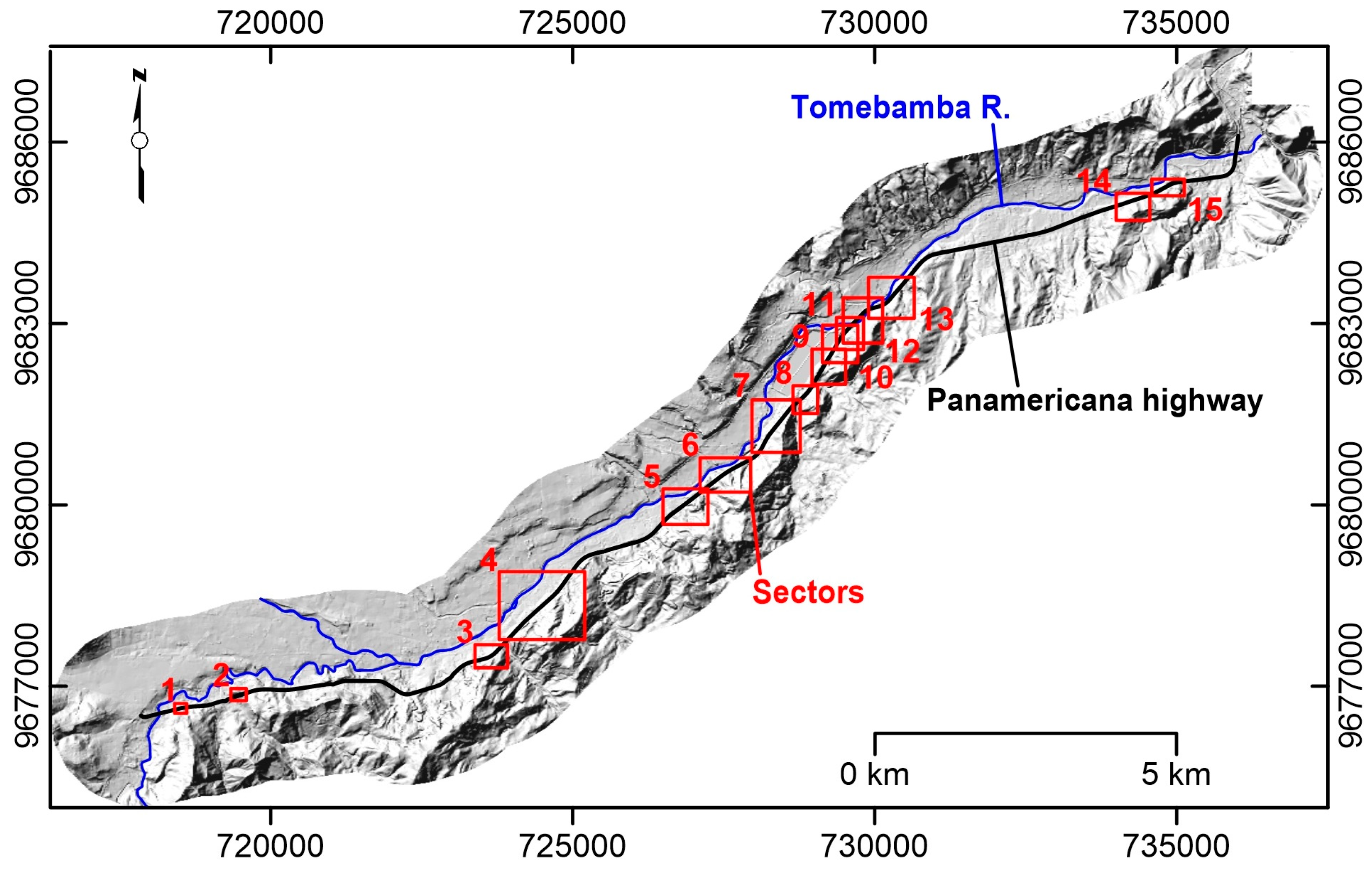

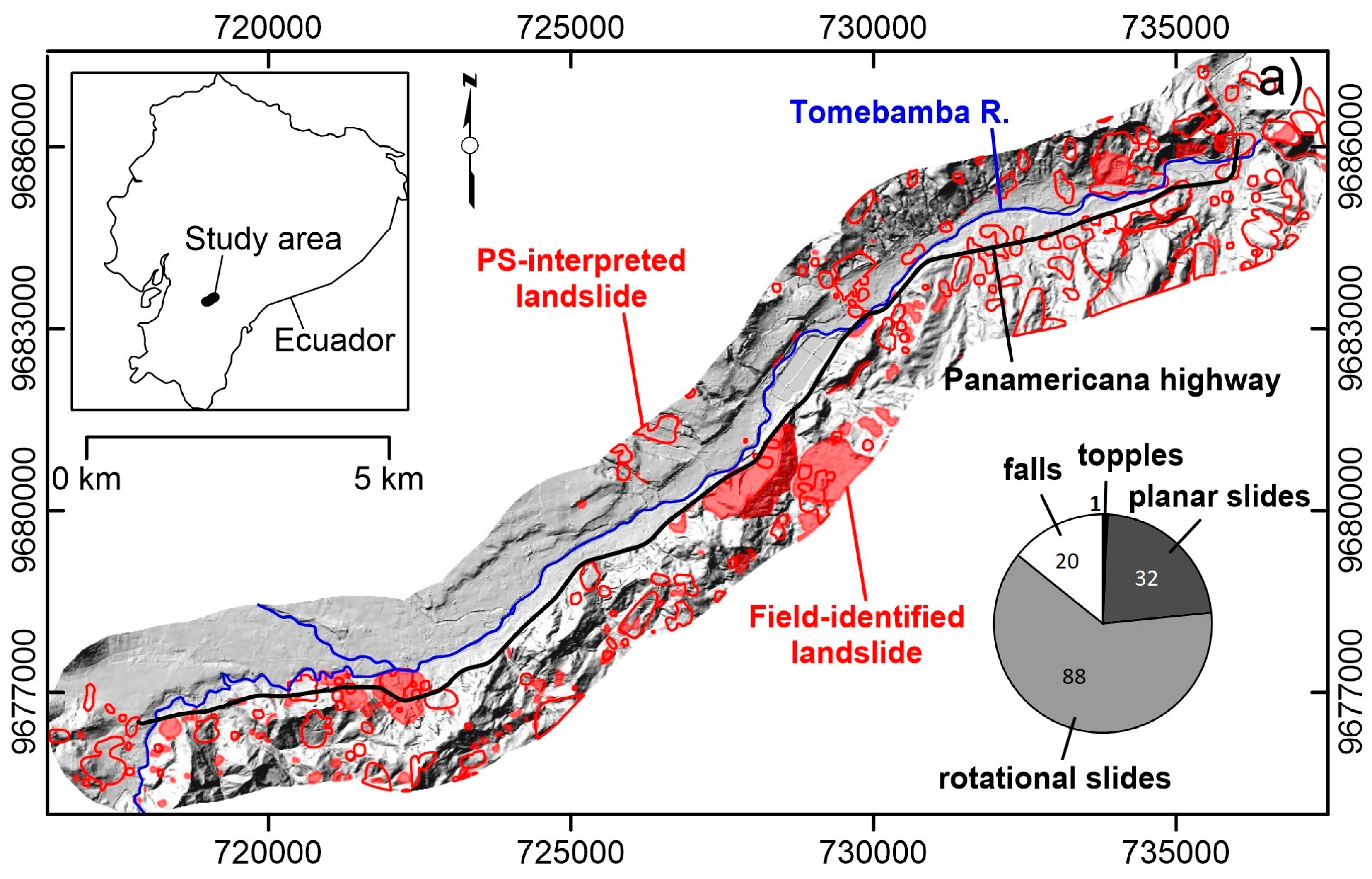
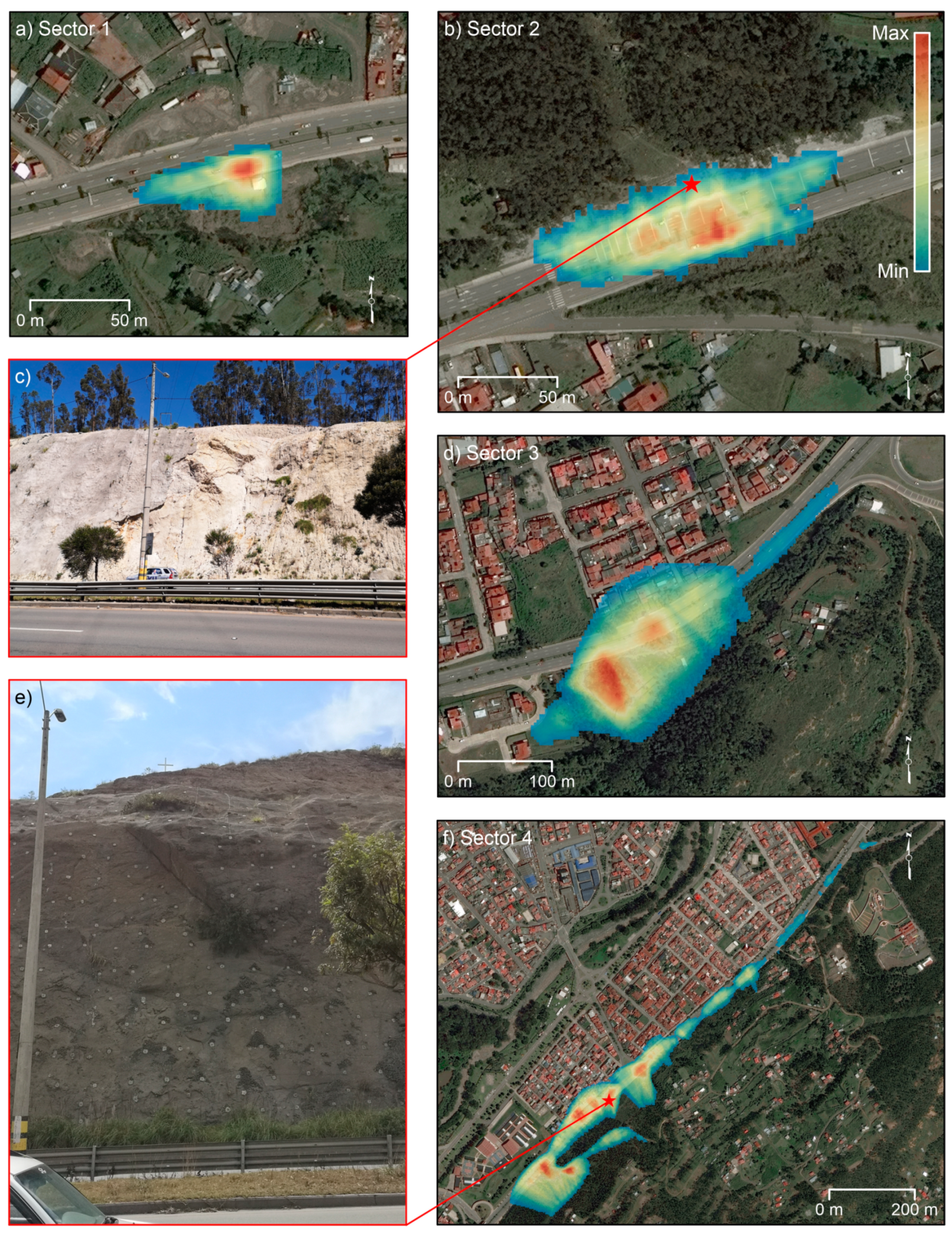
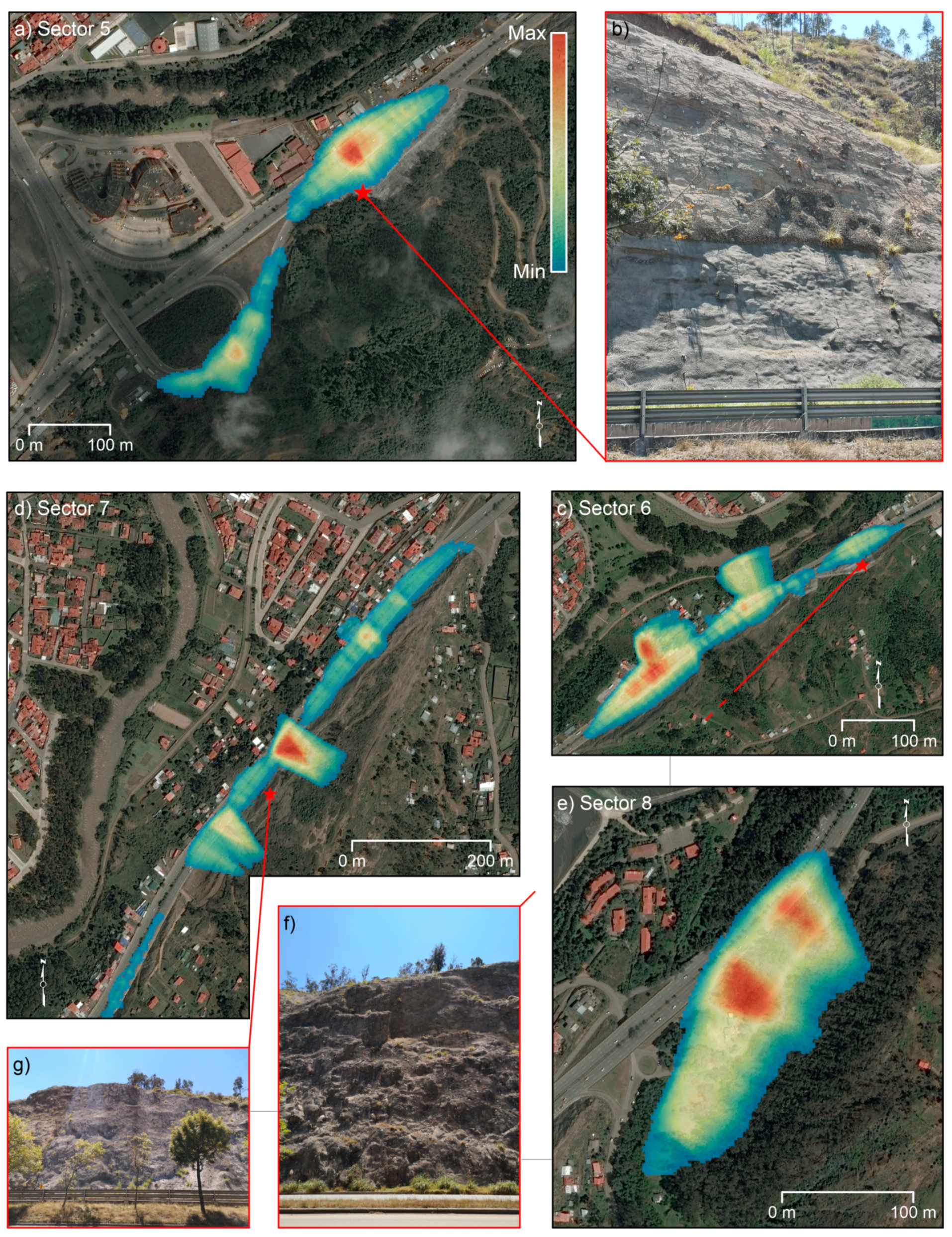



| Satellite | Orbit | Time Span | Nr Scenes |
|---|---|---|---|
| Sentinel-1 | Ascending | 1 October 2016–25 May 2019 | 114 |
| Sentinel-1 | Descending | 10 October 2016–16 May 2019 | 99 |
| Rotational Slide | Planar Slide | Fall | Topple | Total | |
|---|---|---|---|---|---|
| Field-surveyed landslides | 6 | 3 | 20 | 1 | 30 |
| Remote-sensed landslides | 82 | 29 | - | - | 111 |
Publisher’s Note: MDPI stays neutral with regard to jurisdictional claims in published maps and institutional affiliations. |
© 2021 by the authors. Licensee MDPI, Basel, Switzerland. This article is an open access article distributed under the terms and conditions of the Creative Commons Attribution (CC BY) license (https://creativecommons.org/licenses/by/4.0/).
Share and Cite
Miele, P.; Di Napoli, M.; Guerriero, L.; Ramondini, M.; Sellers, C.; Annibali Corona, M.; Di Martire, D. Landslide Awareness System (LAwS) to Increase the Resilience and Safety of Transport Infrastructure: The Case Study of Pan-American Highway (Cuenca–Ecuador). Remote Sens. 2021, 13, 1564. https://doi.org/10.3390/rs13081564
Miele P, Di Napoli M, Guerriero L, Ramondini M, Sellers C, Annibali Corona M, Di Martire D. Landslide Awareness System (LAwS) to Increase the Resilience and Safety of Transport Infrastructure: The Case Study of Pan-American Highway (Cuenca–Ecuador). Remote Sensing. 2021; 13(8):1564. https://doi.org/10.3390/rs13081564
Chicago/Turabian StyleMiele, Pietro, Mariano Di Napoli, Luigi Guerriero, Massimo Ramondini, Chester Sellers, Mariagiulia Annibali Corona, and Diego Di Martire. 2021. "Landslide Awareness System (LAwS) to Increase the Resilience and Safety of Transport Infrastructure: The Case Study of Pan-American Highway (Cuenca–Ecuador)" Remote Sensing 13, no. 8: 1564. https://doi.org/10.3390/rs13081564
APA StyleMiele, P., Di Napoli, M., Guerriero, L., Ramondini, M., Sellers, C., Annibali Corona, M., & Di Martire, D. (2021). Landslide Awareness System (LAwS) to Increase the Resilience and Safety of Transport Infrastructure: The Case Study of Pan-American Highway (Cuenca–Ecuador). Remote Sensing, 13(8), 1564. https://doi.org/10.3390/rs13081564








